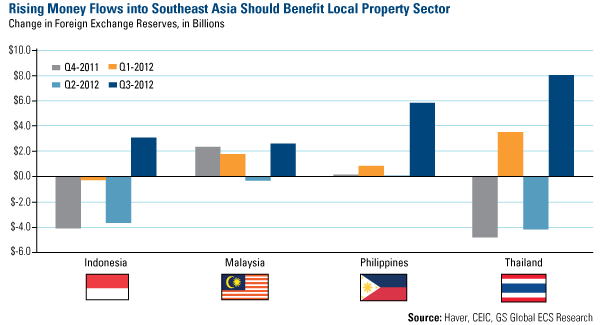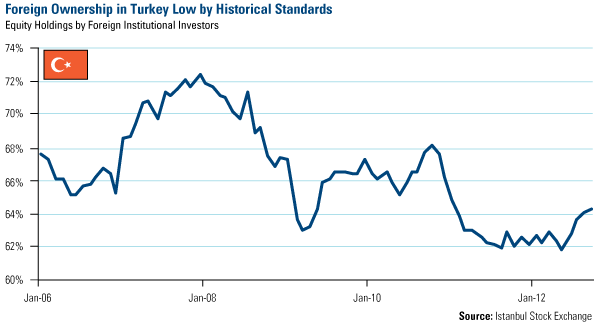Emerging Markets Radar (October 28, 2012)
Strengths
- The HSBC China October flash manufacturing Purchasing Manager’s Index (PMI) improved 1.2 percent to 49.1 from 47.9 in September. The breakdown of the index shows some positive signs, such as the running down of inventories and improving new orders. The market was encouraged by the improving PMI, though it is still below 50, indicating that industrial activities are in contraction.
- Data from the China Banking Regulatory Commission (CBRC) showed that for the first nine months, loan balances for social security housing constructions at banking institutions went up 47.6 percent on a year-over-year basis, which should benefit construction companies.
- The Philippines cut interest rates by a quarter of a percentage point to a record-low 3.5 percent in the week. This was the fourth time this year to spur growth and dampen currency gains as U.S. monetary stimulus threatens to boost capital inflows.
- Thailand’s September exports were slightly up by 0.2 percent on a year-over-year basis, beating the market consensus which had predicted a contraction.
Weaknesses
- Korea’s GDP decelerated to 1.6 percent in the third quarter this year, below the consensus forecast of 1.7 percent. This was the slowest growth in three years since the third quarter of 2009 due to weak capital spending and destocking, but economists said it could be the bottom of the cycle.
- Out of 935 companies listed in the Shanghai Composite, 161 have reported third-quarter earnings with profits falling an average 4.5 percent from a year earlier, but analysts encouraged investors to look beyond reported earnings, rather than paying attention to earning revisions in the reporting season.
- In spite of the market consensus that The People’s Bank of China (PBOC), the central bank, would cut interest rates at least once and cut the bank reserve ratio one to two times before year-end, that hope has diminished lately due to increasing reverse repo operations by the central bank. Similarly, the market may have overestimated the probability of a large stimulus package around the national congress on November 8.
- In its recent research report, JP Morgan predicts Korea’s economically active population to peak in 2012/2013, tracking Japan closely in its economic and population dynamics.
Opportunities

- The graph above shows that money flows into Association of Southeast Asian Nations (ASEAN) countries went up in the third quarter due to the U.S. QE3 program. The increasing inflow of money should help inflate asset prices in these countries, particularly benefiting the equity and property markets.
- HSBC makes an ongoing case for Turkey, even after its very strong run, up 45 percent year-to-date in U.S. dollar terms. The chart below shows that foreign ownership is still low by historical standards.

- Turkish corporations improved their competitive position dramatically over the past five years. Net profit margins expanded as unit labor costs have fallen, the opposite of all the BRIC (Brazil, Russia, India and China) countries.

Threats
- Indonesia’s current account (CA) balance turned into a deficit this year due to reduced demand from China for its commodities and lower coal and rubber prices. CLSA forecasts Indonesia’s CA could be worse than India next year, reaching 3 percent of GDP. This widened CA deficit is mostly due to a weak external market, with strong domestic demand for external consumer and industrial goods. A number of economic forces can act to dampen or reduce the impact of the CA deficit, including continuing FDI (foreign direct investment) inflow, global recovery, and productivity-enhancing domestic policies.
- Mark Mobius expressed his concern to the Russian business paper Vedomosti about the fate of minority investors in TNK-BP Holding following its acquisition by the state company Rosneft. Despite consolidation, Rosneft CEO Igor Sechin said that there are no plans for a minority share buyout. Mobius declined to comment how the deal reflects on the investment climate in Russia.
- A BCA Research valuation ranking shows that currencies of commodity-producing nations, such as Brazil, Chile, Indonesia and Russia, are the most expensive, which makes them particularly vulnerable if commodity prices head lower. BCA ranks emerging markets currencies based on an average of two valuation measures: the deviation of the real effective exchange rate from its 10-year mean and purchasing power parity. On the other hand, the Indian rupee has the most upside by this measure.












